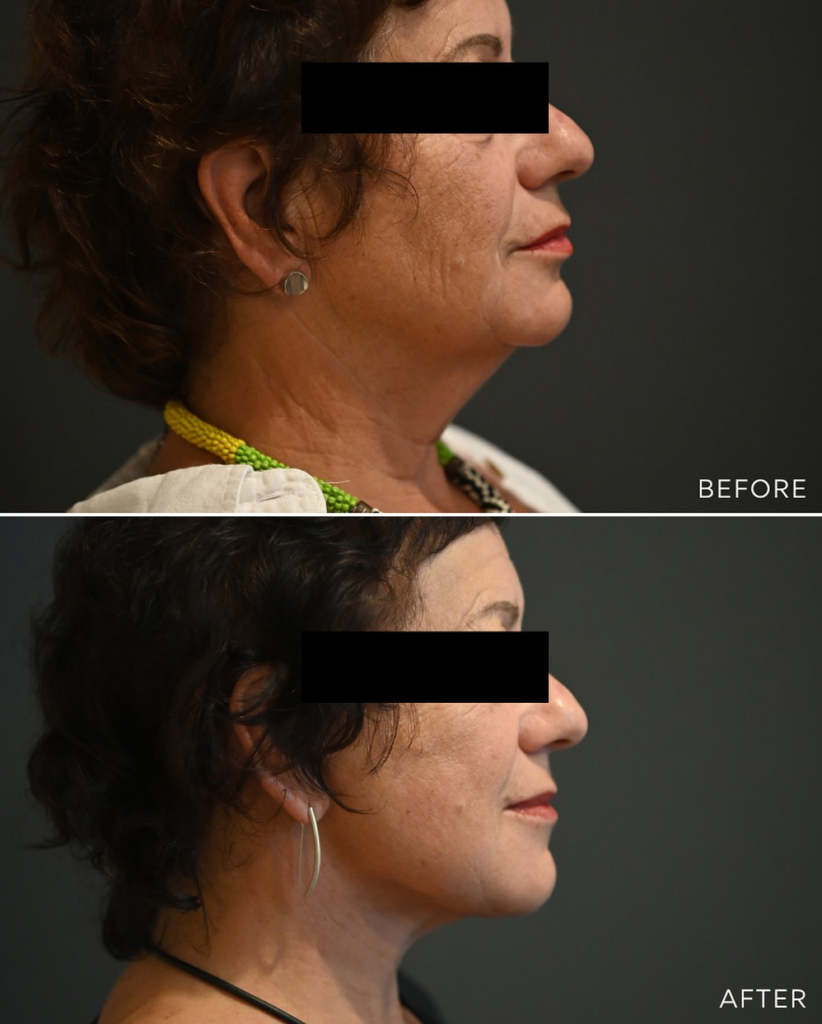What Is A Direct Neck Lift?
Model featured in photography

Disclaimer: Results vary and are illustrated as a guide only.
Ageing is a natural process that affects everyone differently, and some people may seek ways to address skin ageing-related changes, such as loose skin around the neck. A direct neck lift is one option that may help address this concern. This blog will provide an overview of what a direct neck lift involves, offering general information to help you better understand this approach.
For advice tailored to your individual needs, a consultation with a qualified health professional is always recommended.
Understanding the Direct Neck Lift
A direct neck lift is a surgical procedure designed to remove excess skin and tighten the underlying muscles in the neck. Unlike a traditional neck lift, which involves incisions around the ears and sometimes beneath the chin, a direct neck lift operation focuses on making an incision directly in the front of the neck.
What to Expect During the Procedure
Consultation: The first step is to get a referral from your GP and schedule a detailed consultation with a qualified plastic surgeon. During this session, the surgeon will assess your neck, discuss your goals, and explain the procedure in detail. They will also evaluate your overall health and suitability for surgery, which includes conducting a BDD screening
Pre-Operative Preparations: You may be advised to stop taking certain medications, avoid smoking, and follow specific guidelines to prepare for surgery.
The Surgery: On the day of the procedure, you will be given either local anaesthesia with sedation or general anaesthesia, depending on the surgeon’s recommendation and your comfort level. The surgeon will make an incision in the front of the neck, carefully remove excess skin, and tighten the underlying muscles. The incision is then closed with sutures, and a dressing is applied to minimise swelling and support the new contours of your neck.
Recovery: Rest is an important part of the recovery process, and the time required before resuming regular activities can vary for each individual. Temporary bruising and swelling are common and may take some time to settle. It’s essential to follow the care instructions provided by your health professional to support your recovery. For personalised advice on what to expect and how to care for yourself during the recovery period, consult with your qualified healthcare provider.
Costs Involved
The cost of a neck lift can vary widely based on several factors, including the surgeon’s experience, the complexity of the procedure, anaesthesia and accredited facility fees, and post-operative care. It’s essential to discuss all costs upfront during your consultation to avoid any surprises.
Potential Risks and Complications
As with any surgical procedure, a direct neck lift carries certain risks, including bleeding, nerve weakness, scarring.It’s important to discuss these risks thoroughly with your surgeon to ensure you are well-informed before proceeding.
It’s important to understand the procedure and have realistic expectations about the results. While a direct neck lift can provide significant improvements, it won’t stop the ageing process. If you want to learn more about this procedure, reach out to Artiste Plastic Surgery. You can discuss your goals with our peer-reviewed Specialist Plastic Surgeon, Dr Jack Zoumaras, to help align expectations with achievable outcomes. Book a consultation today.
Disclaimer: At Artiste Plastic Surgery, our Plastic Surgeons led by Dr Jack Zoumaras have been trained to the highest possible degree. All plastic surgery is invasive and has risks, and it is always advised to get a second opinion. Risks are very real and we cannot guarantee any result. Results are illustrated as a guide only. All risks are managed and any need for revision surgery or complications (1-5%) can be managed by our specialist plastic surgeons. Recovery varies between 1-4 weeks. More information on our website.
Any statements on how you will feel is based on Level V Evidence:
Level V: How you will feel after plastic surgery varies between individuals, depending on psychological and physical factors. Our internal research is based on how patients in our practice feel after surgery.
The blogs are not a substitute for a medical consultation and do not form as part of the doctor to patient relationship.
SHARE THIS ARTICLE
Oct08
Upper vs Lower Eyelid Surgery: What’s the Difference
Disclaimer: At Artiste Plastic Surgery, our Plastic Surgeons led by Dr Jack Zoumaras have been trained to the highest possible degree. All surgery has risks and it is always advised ...
Oct08
Blepharoplasty for Hooded Eyes: Before & After Guide
Disclaimer: At Artiste Plastic Surgery, our Plastic Surgeons led by Dr Jack Zoumaras have been trained to the highest possible degree. All surgery has risks and it is always advised ...
ABOUT ARTISTE
Artiste Plastic Surgery is an Award Winning Specialist Plastic Surgery practice led by internationally trained Dr. Jack Zoumaras, Plastic Surgeon and Peer Reviewed Face Surgeon
Artiste offers the latest Cosmetic Surgical Procedures of the Face, Breast and Body, inspired from leading centres around the world.
STAY IN THE LOOP
Enter your email address below to receive updates on new articles and VIP access to promotions and special offers.
FOLLOW US ON INSTAGRAM
